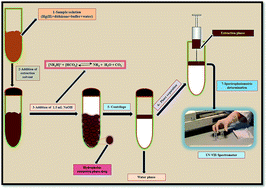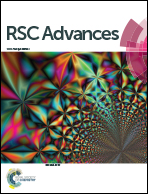Switchable solvent based liquid phase microextraction of mercury from environmental samples: a green aspect
Abstract
A novel and environmentally friendly approach using switchable solvent based liquid phase microextraction (SPS-LPME), followed by UV-vis-spectrophotometric determination has been developed for the preconcentration and determination of mercury. Dithizone was used as a complexing reagent that forms a hydrophobic complex with Hg(II) which was determined spectrophotometrically using a UV-vis spectrophotometer at 574.7 nm. The N,N-Dimethyl-cyclohexylamine/protonated N,N-dimethyl-cyclohexylamine carbonate solvent pair was used as a switchable solvent in the presented work. The average relative standard deviation was 0.8% for five repeated determinations at 1.06 μg L−1 of Hg(II) concentration. Analytical parameter like the limit of detection (LOD), limit of quantification (LOQ) and enhancement factor (EF) were calculated as 0.19 μg L−1, 0.62 μg L−1 and 40, respectively. The accuracy of method was evaluated by analyzing NCS ZC81002B human hair certified reference material. The method was successfully applied to the determination of mercury in water and hair samples with satisfactory results.


 Please wait while we load your content...
Please wait while we load your content...